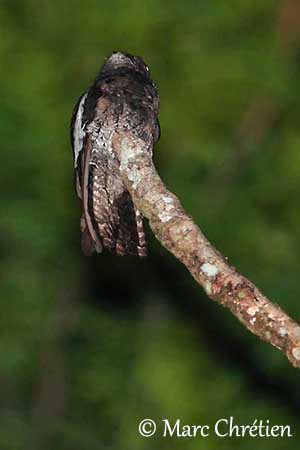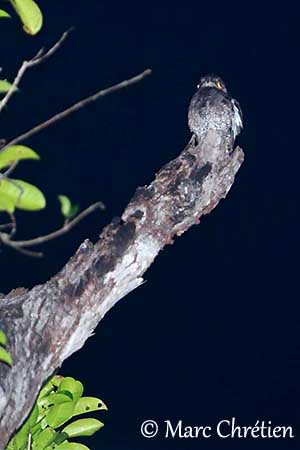
Fr: Ibijau à ailes blanches
Ang: White-winged Potoo
All: Weißflügel-Tagschläfer
Esp: Nictibio Aliblanco - Urutaú de Alas Blancas
Ita: Nittibio alibianche
Nd: Witvleugelreuzennachtzwaluw
Sd: vitvingad poto
Port: Urutau-de-asa-branca
Photographer:
Marc Chrétien
MURINUS
Text by Nicole Bouglouan
Sources:
HANDBOOK OF THE BIRDS OF THE WORLD Vol 5 by Josep del Hoyo-Andrew Elliott-Jordi Sargatal - Lynx Edicions - ISBN: 8487334253
NIGHTJARS - A Guide to Nightjars and Related Nightbirds – Nigel Cleere and Dave Nurney - Yale University Press - First Edition (August 11, 1998) - ISBN 10: 0300074573 / ISBN 13: 9780300074574
BirdLife International (BirdLife International)
Wikipedia, the free encyclopaedia
Rediscovery of Nyctibius leucopterus (White-winged Potoo) in the Atlantic Forest of Brazil
White-winged Potoo - Nyctibius leucopterus: The first photos of a near-mythical bird
By Tanguy Deville, Olivier Claessens and Alexandre Renaudier
White-winged Potoo
Nyctibius leucopterus
Caprimulgiformes Order – Nyctibiidae Family
INTRODUCTION:
The White-winged Potoo is closely related to the Andean Potoo as they share a common ancestor, the Common Potoo.
It lives in primary forest and humid forests, and like other potoos, it is nocturnal. Its cryptic plumage differs from other species by the broad, white wing-panel. It is one of the smallest potoos.
This species has a wide range in the Amazon Basin, and an isolated population occurs in E Brazil. Its plaintive, haunting whistle is mainly heard during the night, and especially on moonlit nights.
DESCRIPTION OF THE BIRD:
Biometrics:
Length: 24-29 cm
Weight: 77-85 g
The adult has greyish-brown, streaked blackish-brown upperparts. On the upperwing, a broad, white wing-panel is formed by the whitish wing-coverts, but it is often obscured by the scapulars. The hindneck shows an indistinct greyish-white to pale buffish collar.
On the underparts, chin and throat are greyish-white, and the rest is greyish-brown with blackish-brown streaks and spots.
The bill is blackish. The eyes are yellow. Legs and feet are pale brownish.
Both adults are similar, but the female has smaller and duller wing-patch.
The juvenile is not described.

RANGE:
The White-winged Potoo is found in the lowlands of Amazonia in E Venezuela, N Brazil, the Guianas and E Peru. These localities are distantly scattered.
An isolated population occurs in E Brazil (Bahia and Espirito Sancto). The birds of E Brazil are larger than the Amazonian specimens.
HABITAT:
The White-winged Potoo usually frequents primary and humid forests, and generally undisturbed forests. It is also found near streams in tall Mora-dominated forest, and on the edges of rivers in seasonally flooded Mora forests. This species is visible from sea-level up to 900 metres of elevation.
CALLS AND SONGS: SOUNDS BY XENO-CANTO
The White-winged Potoo gives short, high-pitched “hweep” as contact call or in flight. This call is often repeated several times in rapid series.
The song is a haunting, plaintive whistle descending in pitch “weuuuuuuuuuuu” given from high perch in the canopy, usually up to 40 metres above the ground. It sings mainly at night, and especially on moonlit nights.
The voices of the White-winged Potoos from different parts of the range show a remarkable uniformity in both songs and calls.
BEHAVIOUR IN THE WILD:
The White-winged Potoo feeds on small and medium-sized insects of various species such as beetles, moths, cicadas, mantids, orthopterans, winged termites and true bugs.
Like other potoos, it hunts from perches by sallying into the air. This species is nocturnal and forages at night.
The breeding behaviour is unknown, but we can suggest that it is fairly similar to that of other Nyctibiidae. They are monogamous and both adults share all the nesting duties.
It roosts solitary during the day, perched in trees in upright stance, often at tip of broken stubs.

The White-winged Potoo is sedentary in its range.
It flies like an enormous butterfly and the flight is silent.
REPRODUCTION OF THIS SPECIES:
Like other potoos, the White-winged Potoo does not build a nest. The egg is laid in a depression on a branch in tree, or at top of a broken stub.
The female lays a single egg and both adult incubate. The chick is fed at night. It leaves the nest when it is about 2/3 the size and weight of the adults. It is able to fly. However, it still depends on parents for food for some time.
PROTECTION / THREATS / STATUS:
The White-winged Potoo from E Brazil is probably restricted to patches of Atlantic rainforest where it is threatened due to its small population.
The Amazonian potoos may be relatively common in their range, but they are patchily distributed. The main threat in Amazonia is the destruction of the forest.
The White-winged Potoo is suspected to be declining due to habitat destruction, but even being a rare bird (probably due to its cryptic plumage making it invisible), this species is currently evaluated as Least Concern.